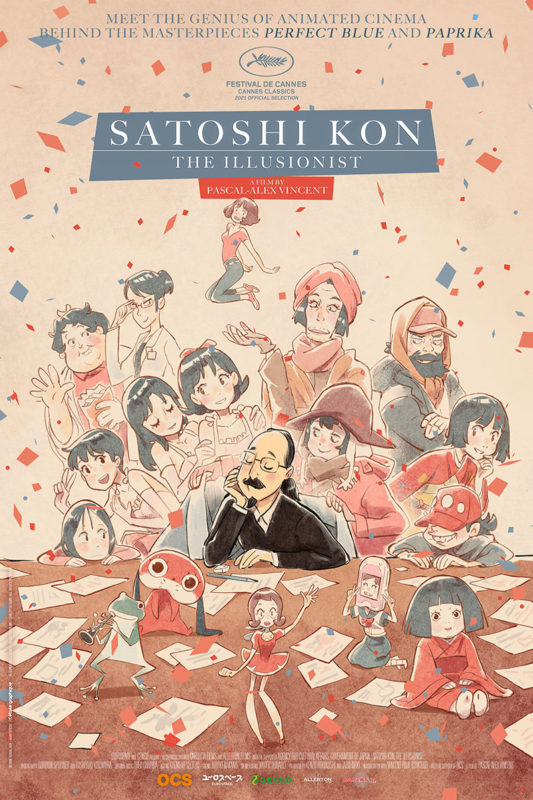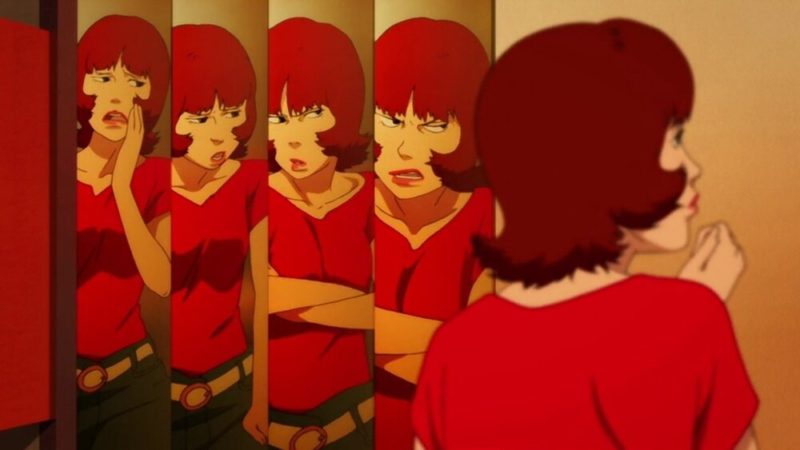
“Animation doesn’t have to look real. It has to feel real.” Rodney Rothman observes in Satoshi Kon: The Illusionist. A titular documentary about one of cinema’s greatest animation auteurs. Rothman is referring to Kon’s unique approach of blending dreams and reality. A common thread among Kon’s thematically diverse career. Rothman also declares that Satoshi’s films were his biggest inspiration when he was prepping Spider-Man: Into The Spiderverse, which won him an Academy Award. Although Rothman wasn’t the first American director to take inspiration in Kon’s undeniable work. More on that later.
Satoshi Kon’s early work was in Manga, where right out of the gate he made a defining name for himself. Kon states he was heavily inspired by the work of cyberpunk author Katsuhiro Otomo (Akira). Audiences and critics agreed, and Kon quickly shot up to stardom, resulting in the option to direct Yoshikazu Takeuchi’s psychological drama Perfect Blue. Kon unsurprisingly wanted to make adjustments from the original Manga, stating he wanted “A story about a man chasing a woman, and a story about a woman chasing her shadow.” The ending result, a critical masterpiece of psychological horror. With themes about the public’s predatory obsession of female pop stars, loving celebrities through television, and internet bullying, Perfect Blue was way ahead of it’s time. Unfortunately, Japanese audiences did not connect with the lurid content.

However, Darren Aronfosky was a big fan. He had met Kon at a screening of Pi the previous year, and the duo hit it off as friends. Aronofsky wrote Kon and asked if he could homage him. He copied the iconic bathtub scene identically in Requiem for a Dream. Side note: Aronofsky only mentions this one homage. However, as any viewer can quickly pinpoint, Aronofsky pulled from MANY of Kon’s ideas in Requiem (and Black Swan).
Kon’s next film Millennium Actress took inspiration from George Roy Hill’s Slaughterhouse-Five, serving as a sort of spiritual sequel. Millennium Actress is the story of a camera crew who meet an actress in her twilight years who is able to travel through time. Kon effortlessly weaves a film is part semi-biographical, part metaphysical journey, part mystery, and part critique on wartime propaganda. Critics praised the film. Audiences remained lukewarm.
His next film faired stronger. Tokyo Godfathers is a pseudo remake of the western, Three Godfathers. The story of three men stumbling upon a lost baby had been remade twice before. However this time, Kon being Kon, switched the John Wayne character into a homeless drag queen, and the old West into trash-filled modern Tokyo. The end result is arguably Kon’s most accessible film.
Next, wanting to try something different, Kon decided to take a stab at the Western sensation, Twin Peaks. Paranoia Agent was his first and only foray in televised serials, but the end result was consistent with his theatrical output. Stellar. The story centered around a mysterious skater kid who is beating townsfolk with a baseball bat, only to improve the recipients lives. It’s gloriously odd and dreamy. Filled with the titular promise, paranoia.

However Paranoia Agent‘s dreaminess was merely a precursor to Kon’s next and final film Paprika. Paprika is the story about a machine that allows therapists to go into patient’s dreams to investigate and find their truth. Unfortunately, the dream machine is stolen and is being used for nefarious reasons when local deaths start to occur. A brown suit detective must team up with the practice’s leading therapist, Atsuko (and her dream-self Paprika), to find out and stop whoever it is pulling the strings. Sounds familiar? It is. Many dream, time and space bending scenes (not to mention plot points) are ripped off in Christopher Nolan’s colossal hit Inception. Nolan makes no appearance in the documentary. Side note: no in-credit “Thank You” to Kon in Inception. A shame Paprika is mostly unknown by American audiences. A shame ripping off artists is the norm in Hollywood.
Kon died three year’s after Paprika‘s release. However, he worked on a final film, Dreaming Machine, that alas, did not make it into production. Cancer took him at the age of 46.
Much praise as is given in remembrance of Kon from colleagues, voice actors, anime historians and an impressive list of admirers. If there is any defining quality of Kon’s work stated by the interviewees, it is that he was a perfectionist, and a grand illusionist. However, his colleagues point out that Kon was as much a force of nature with his temper. A temper that could range from highly collaborative, to screaming stand stills.
But the trail that he blazed in the expansion of contemporary animation defies any criticism a former friend may have. As one of the closing lines of film states, given from an ex-animator who walked off Kon’s final project due to unruly questions of personal commitment. “The reason I do this documentary, is to tell you I am grateful to have worked with Satoshi Kon.” as tears roll down his cheek. There is a sacrifice for excellence. However, the lasing power of brilliance forgives all wounds.
Cinema lives forever, and Satoshi Kon certainly has left an impression. Seek this documentary out. It is a fantastic look into the work of one of the 20th Century’s greatest filmmakers. Go seek out Kon’s work. All of it.
Satoshi Kon: The Illusionist was screened digitally at the 2021 Fantasia Film Fest.




